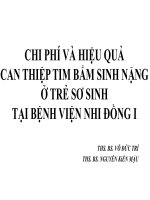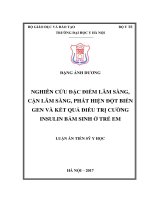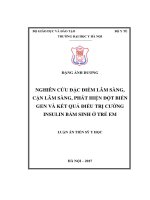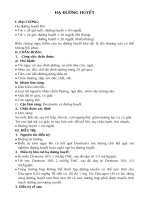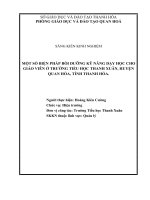Hạ đường máu nặng do cường Insulin bẩm sinh ở trẻ sơ sinh: kiểu gen và kiểu hình của 102 bệnh nhân_Tiếng Anh
Bạn đang xem bản rút gọn của tài liệu. Xem và tải ngay bản đầy đủ của tài liệu tại đây (1.56 MB, 36 trang )
<span class='text_page_counter'>(1)</span><div class='page_container' data-page=1>
<b>CONGENITAL HYPERINSULINEMIC </b>
<b>HYPOGLYCEMIA IN INFANTS: GENOTYPE </b>
<b>AND PHENOTYPE OF 102 CASES </b>
<i><b>Can Thi Bich Ngoc, Vu Chi Dung et al </b></i>
</div>
<span class='text_page_counter'>(2)</span><div class='page_container' data-page=2>
<b>Introduction </b>
• Congenital hyperinsulinism (CHI): inappropriate
of insulin secretion despite low blood glucose
levels
• Absence of treatment → irreversible brain
damage
</div>
<span class='text_page_counter'>(3)</span><div class='page_container' data-page=3>
Insulin secretion in the pancreatic beta-cell
<b>Ca2+</b>
<b>Voltage </b>
<b>dependent </b>
<b>Ca2+<sub> channel </sub></b>
</div>
<span class='text_page_counter'>(4)</span><div class='page_container' data-page=4>
<b>Summary of genetic causes of isolated HI </b>
<b>Gene</b> <b>Protein</b> <b>Inheritance</b> <b>Diazoxide-Resp.</b> <b>Histology</b> <b>Comment</b>
<b>K<sub>ATP </sub>Channel</b> <i><b>ABCC8 </b></i> SUR1 AR No F or D
AD Usually D
<i><b>KCNJ11 </b></i> Kir6.2 AR No F or D
<b>Enzymes/Transporters</b> <i><b>GLUD1 </b></i> GDH AD or DN Yes D HIHA syndrome
<i><b>GCK </b></i> GCK AD or DN Usually D MODY 2
<i><b>HADH </b></i> SCHAD AR Yes D
<i><b>SLC16A1 </b></i> MCT1 AD Usually D EIHI
<i><b>UCP2 </b></i> UCP2 AD Yes D
<b>Transcription Factor</b> <i><b>HNF4A </b></i> HNF4A AD or DN Yes D MODY 1
<b>AR</b>: autosomal recessive; <b>AD</b>: autosomal dominant; <b>DN</b>: De Novo; <b>F</b>: Focal Form; <b>D</b>: Diffuse Form; <b>HI/HA</b>:
hyperammonemia/hyperinsulinism syndrome; <b>EIHI</b>: Exercise-induced hyperinsulinism; <b>GDH</b>: Glutamate Dehydrgenase;
<b>GCK</b>: Glucokinase; <b>HADH</b>: Hydroxy-Acyl-CoA Dehydrogenase; <b>MCT1</b>: Monocarboxylate transporter 1; <b>MODY</b>:
Maturity-onset diabetes of the young: <b>UCP2</b>: Uncoupling protein 2.
</div>
<span class='text_page_counter'>(5)</span><div class='page_container' data-page=5>
<b>BACKGROUND </b>
<b> Beta-cell potassium ATP (K<sub>ATP</sub>) channel genes </b>
• <i>ABCC8</i> gene: 39 exons, 100 kb, encoding a
1582-amino acids protein (SUR1)
• <i>KCNJ11</i> gene: single exon encoding a
390-amino acid protein (Kir6.2)
• Interestingly, location of <i>KCNJ11</i> only 4.5 kb
from <i>ABCC8</i> gene on 11p15.1
• <i>GLUD1</i>: 45 kb; 13 exons on 10q23.2
</div>
<span class='text_page_counter'>(6)</span><div class='page_container' data-page=6>
<b>Hyperinsulinism results from </b>
<b>loss-of-function K</b>
<b><sub>ATP</sub></b><b> channel mutations</b>
</div>
<span class='text_page_counter'>(7)</span><div class='page_container' data-page=7>
• Diazoxide blocks insulin secretion by activating
(opening) SUR1
</div>
<span class='text_page_counter'>(8)</span><div class='page_container' data-page=8>
<b>SPECIFIC AIMS </b>
• <i>To identify mutations in the ABCC8 and KCNJ11, </i>
<i>HNF4A and GLUD genes </i>
</div>
<span class='text_page_counter'>(9)</span><div class='page_container' data-page=9>
<b>PATIENTS </b>
• Patients
102 cases with CHI at NHP (male: 60; female:42)
Diagnosis age: 1 - 30 days of age
</div>
<span class='text_page_counter'>(10)</span><div class='page_container' data-page=10>
<b>PATIENTS</b>
<b>Diagnostic criteria (Hussain K. 2008) </b>
1. Fasting & post-prandial hypoglycemia (< 2.5–3 mmol/l)
with unsuppressed insulin secretion & c-peptide levels
(plasma insulin concentrations > 1 mU/l).
2. Positive response to subcutaneous or intramuscular
administration of glucagon (plasma glucose
concentration increase by 2 to 3 mmol/l following a 0.5
mg glucagon subcutaneous injection)
3. Negative ketone bodies in urine or blood
</div>
<span class='text_page_counter'>(11)</span><div class='page_container' data-page=11>
<b>PATIENTS </b>
<b>Excluded criteria </b>
• Syndromic: e.g
Beckwith-Wiedemann
Trisomy 13
Mosaic Turner
• Metabolic conditions
• Secondary to (usually transient)
Maternal diabetes mellitus (gestational & insulin
dependent)
Intra-uterine growth retardation
</div>
<span class='text_page_counter'>(12)</span><div class='page_container' data-page=12>
<b>METHODS </b>
• Genomic DNA was extracted from peripheral leukocytes
using standard procedures.
• Single exon of <i>KCNJ11</i>; 39 exons of <i>ABCC8; 10 exons of </i>
<i>HNF4A & 13 exons of GLUD1</i> were amplified &
sequenced.
• Sequencing reactions were analyzed on an ABI 3730
capillary sequencer & were compared to published
sequences using Mutation Surveyor version 3.24.
</div>
<span class='text_page_counter'>(13)</span><div class='page_container' data-page=13></div>
<span class='text_page_counter'>(14)</span><div class='page_container' data-page=14></div>
<span class='text_page_counter'>(15)</span><div class='page_container' data-page=15>
• Definition of diazoxide efficiency: normalization of
glycemia > 3 mmol/l measured before & after each meal
in patients fed normally with a physiological overnight
fast, after stopping intravenous glucose & any other
medications for at least five consecutive days
<i>Arnoux JB et al. Early Human Development 2010;86:287–294 </i>
• Non responsive with diazoxide
Surgery
Octreotide
</div>
<span class='text_page_counter'>(16)</span><div class='page_container' data-page=16>
<b>RESULTS </b>
<b>CLINICAL SYMPTOMS </b>
Weight of birth: 4.1 0.9 (2.3 – 5.6) kg
Age at presentation: < 24 hours: 47/102 (46.1%)
Symptoms:
</div>
<span class='text_page_counter'>(17)</span><div class='page_container' data-page=17>
<b>RESULTS </b>
<b>Distribution of mutations in different genes </b>
Gene Number of patients %
<i>ABCC8 </i> 47 46.1
<i>KCNJ11 </i> 5 4.9
<i>HNF4A </i> 1 0.9
<i>GLUD1 </i> 0 0
<b>Total </b> <b>53 </b> <b>51.9 </b>
</div>
<span class='text_page_counter'>(18)</span><div class='page_container' data-page=18>
<b>RESULTS </b>
<b>Mutations in ABCC8</b>
• 25 different mutations: 13 novel; 12 reported one
in <i>ABCC8 </i>
• Homozygous/compound heterozygous
mutations in <i>ABCC8 </i>
27/47 (57.4%)
• Hemizygous mutations in <i>ABCC8</i> from father or
mother
20/27 (42,6%)
</div>
<span class='text_page_counter'>(19)</span><div class='page_container' data-page=19>
<b>RESULTS </b>
<b>Mutations in ABCC8 and genotype</b>
<b>Genotype with </b><i><b>ABCC8</b></i><b> mutations </b>
<b>Number of </b>
<b>families </b>
<b>c.3403-1G>A </b> <b><sub>13 </sub></b>
<b>c.3403-1G>A/c.3403-1G>A </b> <b><sub>1 </sub></b>
<b>c.3403-1G>A/c.2995C>T </b> <b><sub>1 </sub></b>
<b>c.2057T>C </b> <b><sub>2 </sub></b>
<b>c.2057T>C/c.2057T>C </b> <b><sub>1 </sub></b>
<b>c.2417G>A/c.2995C>T </b> <b><sub>1 </sub></b>
</div>
<span class='text_page_counter'>(20)</span><div class='page_container' data-page=20>
<b>RESULTS </b>
<b>Mutations in ABCC8 and genotype</b>
<b>Genotype with </b><i><b>ABCC8</b></i>
<b>mutations </b>
<b>Number of </b>
<b>families </b>
<b>c.2041-21G>A/c.3978del </b> <b><sub>1 </sub></b>
<b>c.2041-21G>A/c.2041-21G>A </b> <b><sub>1 </sub></b>
<b>c.2056T>A/c.2057T>C </b> <b><sub>1 </sub></b>
<b>c.2057T>C/c.3403-1G>A </b> <b><sub>2 </sub></b>
<b>c.2057T>C/c.2995C>T </b> <b><sub>1 </sub></b>
<b>c.2995C>T </b> <b><sub>3 </sub></b>
</div>
<span class='text_page_counter'>(21)</span><div class='page_container' data-page=21>
<b>RESULTS </b>
<b>Mutations in ABCC8 and genotype</b>
<b>Genotype with </b><i><b>ABCC8</b></i>
<b>mutations </b>
<b>Number of </b>
<b>families </b>
<b>c.4610C>T </b> <b><sub>1 </sub></b>
<b>c.655C>A/c.892C>T </b> <b>2 </b>
<b>c.1106A>G/ c.4611G>A </b> <b>1 </b>
<b>c.1183A>T </b> <b>1 </b>
<b>c.2056T>A/c.2057T>A </b> <b>1 </b>
<b>c.3293A>G </b> <b>1 </b>
<b>c.4061A>G *</b> <b><sub>1 </sub></b>
<b>c.4135G>A </b> <b>1 </b>
</div>
<span class='text_page_counter'>(22)</span><div class='page_container' data-page=22>
<b>Proband </b>
<b>F686I/F686S </b>
<b>Control </b>
<b>N/N </b>
<b>Father </b>
<b>F686I/N </b>
<b>Mother </b>
<b>F686S/N </b>
<b>RESULTS </b>
</div>
<span class='text_page_counter'>(23)</span><div class='page_container' data-page=23>
<b>RESULTS </b>
<b>Mutations in KCNJ11</b>
3 novel mutations from father (<b>c.482C>T, </b>
<b>c.512C>A, c.820G>C) </b>in 2 unrelated families
</div>
<span class='text_page_counter'>(24)</span><div class='page_container' data-page=24>
<b>RESULTS </b>
<b>Correlation of genotype - phenotype</b>
Responsive with diazoxide: 52 cases:
49 without mutations
1 case with maternal mutation in <i>ABCC8</i>
1 case with mutation in <i>HNF4A </i>
</div>
<span class='text_page_counter'>(25)</span><div class='page_container' data-page=25>
<b>Kết quả </b>
<b>Correlation of genotype - phenotype</b>
Non responsive with diazoxide (surgery and/or
octreotide): 48 cases
4 cases with mutations in <i>KCNJ11 </i>
</div>
<span class='text_page_counter'>(26)</span><div class='page_container' data-page=26>
<b>DISCUSSION </b>
</div>
<span class='text_page_counter'>(27)</span><div class='page_container' data-page=27>
<b>DISCUSSION </b>
• Mutation in ABCC8 (SUR1): most common
cause of CHI and were first to be described
• Approximately 45% of affected individuals have
mutations in <i>ABCC8</i> [Nestorowicz et al 1998, Aguilar-Bryan & Bryan
1999, Meissner et al 1999, Fournet & Junien 2003, Tornovsky et al 2004].
• Almost 20 years after discovery of first mutation
• Over 200 mutations identified
• Distribution of mutations throughout the gene
</div>
<span class='text_page_counter'>(28)</span><div class='page_container' data-page=28>
<b>DISCUSSION </b>
• Diazoxide is effective in virtually all forms of CHI
except in inactivating recessive mutations in
<i>ABCC8 </i>
• Rapid genetic analysis for mutations in <i>ABCC8 & </i>
<i>KCNJ11</i> → identification of majority of patients
with diffuse disease (homozygous or compound
heterozygous mutations)
</div>
<span class='text_page_counter'>(29)</span><div class='page_container' data-page=29></div>
<span class='text_page_counter'>(30)</span><div class='page_container' data-page=30>
<b>CONCLUSIONS </b>
• Understanding genetic basis of CHI provide novel
insights into -cell physiology
• Prediction phenotype, management & genetic
counseling
Genetic analysis for mutation in CHI can help in
genetic diagnosis → treatment
</div>
<span class='text_page_counter'>(31)</span><div class='page_container' data-page=31></div>
<span class='text_page_counter'>(32)</span><div class='page_container' data-page=32></div>
<span class='text_page_counter'>(33)</span><div class='page_container' data-page=33></div>
<span class='text_page_counter'>(34)</span><div class='page_container' data-page=34>
<b>Vuong Ha M; WOB 3.8 kg </b>
</div>
<span class='text_page_counter'>(35)</span><div class='page_container' data-page=35>
<b>Cao Bao N. WOB 5 kg; </b>
</div>
<span class='text_page_counter'>(36)</span><div class='page_container' data-page=36></div>
<!--links-->
Bồi dưỡng kỹ năng sống “thật” cho học sinh docx
- 7
- 354
- 1


